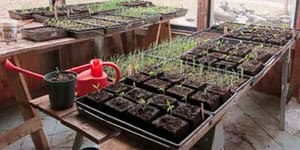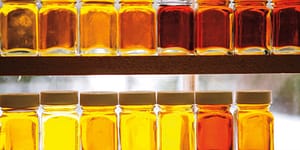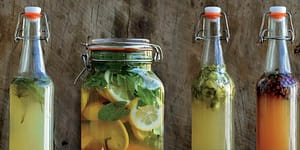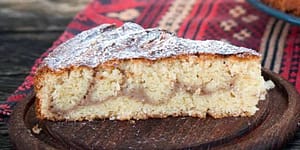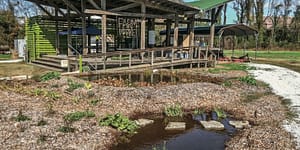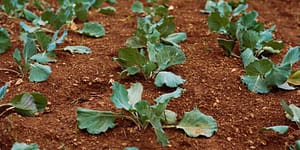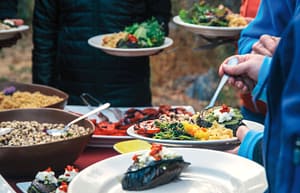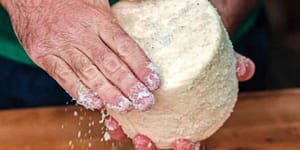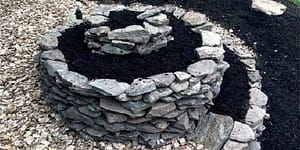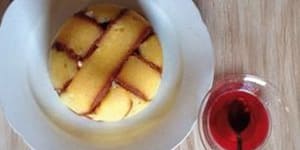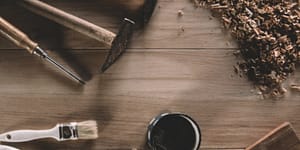Chelsea Green
How you handle your seeds and your practices around seeding is your first chance to get your plants off to a good start and help them achieve their full potential. Ben and Penny Hewitt, authors of The Nourishing Homestead, have developed a three-step process which starts with inoculating the seeds, then sowing them in high-quality…
Read MoreEveryone knows and loves maple syrup, and in some states (like Chelsea Green’s home state of Vermont), it’s big business. However, it’s a widespread myth that maples are the only trees that can be tapped to produce sap, according to Michael Farrell, sugarmaker and director of Cornell University’s Uihlein Forest. Sap can also be collected…
Read MoreThe art of brewing can explore far beyond the usual ingredients into a vast and luminous galaxy of wild and cultivated fruits, berries, grains, and herbs, which once provided a variety of fermented drinks as broad as the world. Now fermentation fans and home brewers can rediscover these “primitive” drinks and their unique flavors in, the…
Read MoreIf you’re ready to start growing a portion of your own food, but you aren’t quite ready for something that requires a big time commitment or a lot of effort, this is a good place to start. Sprouts are easy to cultivate, mature very quickly, can be used in a variety of delicious dishes, and…
Read MoreIf you’re looking for a simple cake to serve guests, try this medlar cream cake. What’s a medlar? The fruit of the medlar tree, Mespilus germanica, tastes like lightly spiced apple butter scooped soft right out of the russeted skin. The Occidental Arts and Ecology Center in California has a small but significant collection of…
Read MoreQ: Let’s start with the title: What is a “bio-integrated farm?” A: When a component in a farm or landscape—which could be a water garden, greenhouse, or chicken coop—performs seven functions, the component becomes alive, and I call this bio-integration. The concept is derived from Bill Mollison’s definition of permaculture design “…assembling conceptual, material and…
Read MoreGet ready for the era of Big Organizing. In Rules for Revolutionaries, authors Becky Bond and Zack Exley lay out the 22 Rules the fueled the Bernie Sanders campaign and which provide a way forward for activists looking for ways to move forward post-Election Day. This model, which the authors call “Big Organizing” is the…
Read MoreAccording to a report in The International Journal of Oncology, giving low dose naltrexone (LDN) to cancer patients can improve the immune system’s ability to kill cancerous cells, as well as improve the efficacy of standard cancer treatments and immunotherapy. This major breakthrough gives research credence to what some doctors have observed in their cancer…
Read MoreJust what are the differences between permaculture and natural farming? How are they connected, and where do they diverge in philosophy and principle? Those questions are answered in One-Straw Revolutionary, a book that delves into the philosophy and work of Japanese farmer and philosopher Masanobu Fukuoka. In this passage, author Larry Korn compares and contrasts two…
Read MoreWith summer in full swing, many are making good use of their outdoor grills. Tender grass fed steaks or free range chicken are often the go-to options, but the possibilities for a grilled meal are endless. At the Occidental Arts and Ecology Center, a summer favorite is Barbecued Eggplant Stacks with Coyote Mint sauce and…
Read MoreWet-hopped beer is the ultimate in seasonal and local brews. It is made from fresh hops picked right off the bine in order to capture the aromatic hop flavor when it is most potent. The tricky part is fresh hops have virtually no shelf life, so brewers must spring into action as soon as the hops…
Read MoreIn today’s world, nearly everything we use, from phones and computers to cars and kitchen appliances, requires energy derived from fossil fuels. Wouldn’t it be nice to offset some of that energy use by harnessing the renewable power of the sun? Josh Trought, founder of D Acres—an educational center in New Hampshire that researches, applies,…
Read MoreCheddar is the world’s most ubiquitous and beloved cheese. You can find it nearly everywhere from macaroni and mousetraps to McDonald’s and mansions. Any cheese with so many fans has a story to tell, and Gordon Edgar is just the cheesemonger to tell it. In his book, Cheddar, Edgar traces the unexplored history of America’s most iconic cheese.…
Read MoreGet ready to change the way you look at cheese. David Asher, author of The Art of Natural Cheesemaking, practices and preaches a traditional, but increasingly countercultural, way of cheesemaking —one that is natural and intuitive, grounded in ecological principles and biological science. Most DIY cheesemaking books are hard to follow and call for the…
Read MoreAs more people flock to urban areas to live, nowhere are the empowering principles of permaculture more needed and desired. In his latest book, bestselling permaculture author Toby Hemenway (Gaia’s Garden) demonstrates that the same nature-based approach that connects the pieces of our landscape together in harmonious ways applies perfectly to our need for water,…
Read MoreFor the days leading up to Earth Day in years past, author Philip Ackerman-Leist runs a Twitter MiniFesto campaign – each day sending out a new tweet designed to spark conversation and pass along some lessons he learned whilst working on his book, Rebuilding the Foodshed. You might also know Philip as the author of…
Read MoreThe herb spiral: A beautiful year-round focal point for your garden that is easy and fun to build and saves both space and water. In Edible Landscaping with a Permaculture Twist, author Michael Judd walks readers through step-by-step instructions on how to create this edibles-producing superstar. In addition to herb spirals, Edible Landscaping covers food forests, raised-bed gardens, earthen…
Read MoreWant to cook your food for free? By building a simple and affordable solar oven, you can use the power of the sun to slow-cook beans and stews and more. This step-by-step guide, illustrated by Rebekah Hren, will show you how to build the oven plus some tips on how to use it. Happy solar…
Read MoreMatthew Stein’s book, When Technology Fails: A Manual for Self-Reliance, Sustainability, and Surviving the Long Emergency, offers this quick guide to making your own shoes. The book is packed with useful tips for saving money, living a sustainable lifestyle, and surviving in a savage, Road Warrior-like dystopia. We hope that will never happen, but if…
Read MoreIs your happy hour missing something? You’re sitting there, enjoying a glass of wine, a pint of beer, or a snifter of scotch — depending upon your tastes. The cares of the week are melting away as you slip under the spell of alcohol, one of the human race’s most ancient and most reliable methods…
Read MoreThe following is an excerpt from Devil in the Milk: Illness, Health, and the Politics of A1 and A2 Milk by Keith Woodford. It has been adapted for the Web. What North Americans should be concerned about is that North American milk is very high in A1 beta-casein, and no one is doing anything about…
Read MoreThe following is an excerpt from Fresh Food from Small Spaces by R. J. Ruppenthal. It has been adapted for the Web. A central problem for many of us who garden in the city is a lack of light. This is covered extensively in the vegetable chapters. I mention it again here only to note…
Read MoreNot everyone is a fan of bees, but when you get down to their level, you start to appreciate all that they do for us; pollinating the flowers and giving us delicious honey. Beekeeping is a noble profession or hobby to take on as you are providing a habitat for your colony to thrive. But…
Read MoreLearn how to make an evaporative cooling box from home this weekend with these helpful & simple tips! The following is an excerpt from The Carbon Free Home: 36 Remodeling Projects to Help Kick the Fossil-Fuel Habit by Stephen & Rebekah Hren. It has been adapted for the Web. How to Make An Evaporative Cooling…
Read MoreFor a cold frame to really work, the light has to be just right. It creates the perfect climate to grow your food when the temperatures make it seem impossible. It can be adjusted to allow for ventilation or more closed to prevent snow or large amounts of water from entering and damaging the plants.…
Read More
